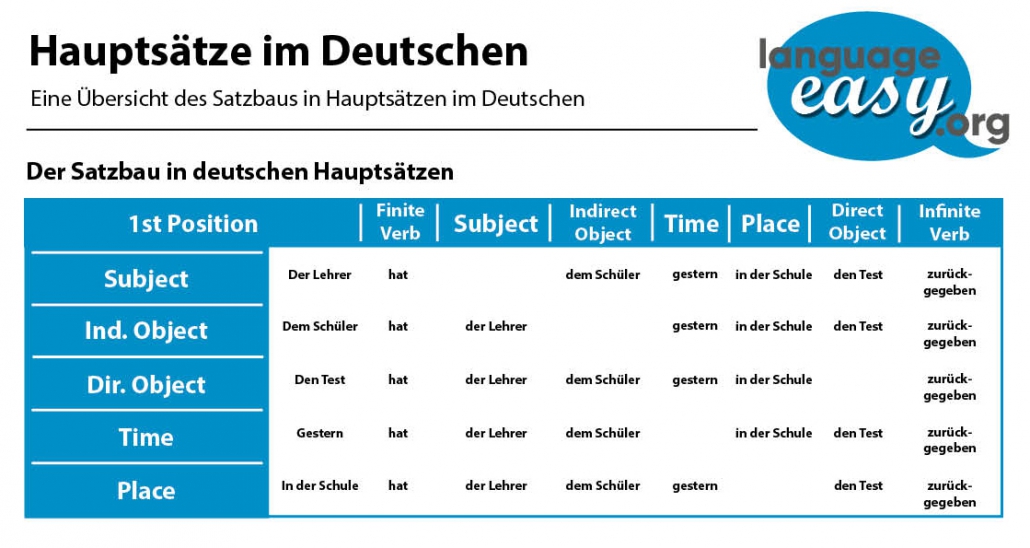German Main Clauses
Die Futurzeiten im Deutschen – Erklärungen und Beispiele
German Main Clauses – Summary
Zusammenfassung
Sentences consist of various words. Certain words can be categorized, due to their grammatical function. There are two basic elements, the subject and the predicate.
The sentence “Der Hund läuft schnell auf der Rennbahn.” describes a real action. Many Germans use certain question to determine the different elements in a sentence. For example “Wer oder was” for determining the subject, “Was geschieht” for the predicate..
- Beispiel: “Der große Hund läuft schnell auf der Rennbahn.“
The Subject (S) is the main word (Noun, N) “Hund”, the Article (A) “der” with the Adjective (Adj) “große”. The predicate (P) consist of the verb (V) “laufen” in its conjugated form “läuft”. An additional element of the sentence is the
Object (OA) in the accusative “Rennbahn” with the Article (A) “der” and the preposition (Pp) “auf”. The last element of the sentence is the adverb (Adv) “schnell”.
- “Der große Hund läuft schnell auf der Rennbahn.”
(A) – (Adj) – (N) – (V) – (Adv) – (Pp) – (A) – (N) – (OA)
Welcome to language-easy.org! Well, as you have clicked on this article, I suppose that you are ready to enter to depths of German sentence structures. So, as a fist and really important sentence type, we will talk about German main clauses in this article. Of course, many of you are familiar with this type of sentence, as it also exists in the English language. Hence, at least its usage should be known to English speakers.
In the following, I’d like to define what a German main clause actually is. After that, we will talk about the word order in this type of sentence and name some basic rules. Finally, I’d like to give you some advice, especially for advances German learners this could be useful.
And now, let’s not lose too much time and come straight to the first topic of this article, a short definition of German main clauses, their correct usage and the basic rules of word order in these sentences.
Los geht’s!
German Main Clauses and Basic Word Order
Hauptsätze und Satzbau im Deutschen
Well, first of all we should clear up what German main clauses actually are. So, in the following, I’d like to give you a short definition of this term.
German main clauses, also called independent clauses or declarative sentences, are clauses that stand alone as a complete sentence. At least, they contain a subject, verb and an object and express and complete thought.
So, after clearing up what a German main clause actually is, let’s go to the next point and talk about the details of the basic word order in this type of sentences.
Luckily, the German main clause is quite similar to the declarative sentences in the English language. As a consequence, you can apply the exact same rules for the basic word order:
- Subject – Verb – Object
Nevertheless, there are some differences, due to the fact that there are the four cases of the German language. So, this allows us to see if a noun or a pronoun is used as a subject or object. Due to this, we can adapt the word order of a German main clause to put the focus on different things. Now, let’s go into some detail about the basic rules of word order in German main clauses.
Basic Rules of German Word Order
So, in this section I’d like to present you the basic rules of German word order. Well, some rules might sound familiar to you as they a similar in English, others differ a lot.
- First, keep in mind that the finite verb is always in the second position of a sentence.
- Second, infinite verb forms like infinitives or past participles are placed at the end.
- Third, the subject is often at the beginning of the sentence. But, other elements like the object, the place or the time can also be in this position. In this case, the subject comes after the finite verb.
Please, keep in mind that in case the direct object is a pronoun, it comes before the indirect object.
Advice for Advanced Learners
Ratschläge für Fortgeschrittene
Of course, there are also a bunch of rules also and possible word order that can not really be considered being “basic”. In the following, I’d like to present some of them. Please, note that that part of this article about German main clauses is more for advanced German learners as a higher level of German is needed to understand it.
Old Before New
So, something that is already known or is assumed to be known, is placed closer to the beginning of a sentence. Often, unknown or new information is placed at the end of the main clause.
Because of that, in case the direct object is a pronoun, it comes before the indirect object. Well, in general, pronouns replace noun that have already been mentioned.
- “Philip hat es (das Fahrrad) ihm (dem Freund) gestern zurückgegeben.”
Furthermore, if the direct object is combined with an indefinite article, it always comes after the time and place. So, keep in mind that you have to use the indefinite article to mention something for the first time.
- “Philip hat seinem Freund gestern ein neues Fahrrad geschenkt.”
Now, let’s come to the next rather advanced rule of word order in German main clauses, about the relationship between sentences.
The Relationship between Clauses
Well, you should always consider that in German written texts you connect the sentences. Of course, it depends on their content. Here, we can put the connective element at the first position of the sentence.
- “Philip war gestern auf einer Party. Sie war sehr lustig.”
Emphasis at the End of the Sentence
Here, the indirect object, the time and place are interchangeable. So, in order to emphasize one on these elements, just put it after the direct obejct.
- “Auf der Party hat Philip gestern ein Mädchen kennengelernt.”
- “Philip hat ein Mädchen gestern auf der Party kennengelernt.”
Well, finally we have reached the end of this section about the advanced rules of word order in German main clauses. So, as I have already mentioned, to know these rules is optional. Nevertheless, they can be really useful in case to want to give to ultimate polish to your German.
Exercises
Übungen
Finally, we have reached the last part of this article where you can prove the German skills you have just learned. In the following you will see some phrases that you should complete with the correct terms. Once you have filled all the gaps, just click on the “correct” button and you can see your errors and the correct results. Good luck and… auf Wiedersehen!



